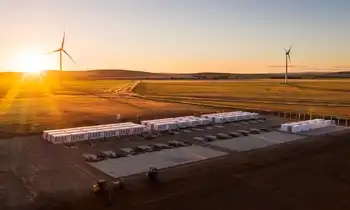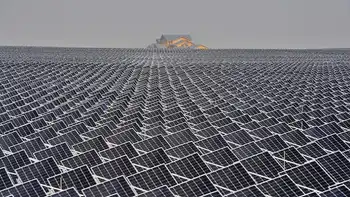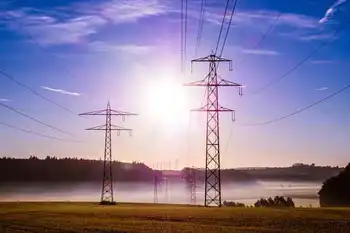Boston Wind-Farm Proposal
BOSTON -- - Proponents of what could be the first-ever offshore wind farm in the nation have scaled back their proposal by 23 per cent, citing efficient new turbines that will allow them to generate the same amount of power with fewer turbines.
Design advances would allow Cape Wind Associates to build 130 towers -- not 170 as originally planned -- and produce the same amount of electricity, the company announced.
The reduced number of turbines would push the wind farm farther from the shores of Cape Cod, Martha's Vineyard and Nantucket, Cape Wind officials said.
The news came on the same day that Cape Wind signed an agreeent with GE Wind Energy, of California, to build turbines for the $700 million project.
Cape Wind president James Gordon said the agreement would provide a boost to the regional economy, since the turbines must be built close to where they would be situated.
"We believe that New England needs to increase its energy diversity and decrease its consumption of fossil fuels," Gordon said during a press conference at the offices of Hale & Dorr, Cape Wind's law firm.
The turbines would have to be built in a "deep-water port" close to Nantucket Sound, Gordon said, citing Quincy as a possibility.
"We see this as a very, very viable source of energy in the future," said Steve Zwolinski, president of GE Wind Energy.
Citing a 31 percent growth rate for wind power worldwide in the last six years, Zwolinski said it has emerged as "the most practical renewable energy solution."
"The project will bring new economic development opportunities to New England with the potential for several hundred new jobs," Zwolinski said.
He said the deal with Cape Wind is worth hundreds of millions of dollars, but would not be more specific. General Electric and Energy Management Inc. have collaborated on energy products for 20 years, Gordon said. The wind farm project is a collaboration between Cape Wind of Yarmouthport and Energy Management of Boston.
Unlike Cape Wind, which filed permit applications for the project with the state and federal governments in November 2001, GE Wind Energy is a relative newcomer to the wind energy industry.
General Electric bought the company from Enron in May 2002, six months after the Houston energy giant declared bankruptcy.
GE Wind Energy, a subsidiary of GE Power Systems, employs 1,500 people and has developed or sold 5,500 wind turbines, according to GE.
The Cape Wind project has generated opposition on the part of property owners, boaters, fishermen and some environmental groups who contend that its drawbacks outweigh its benefits.
Critics say the turbines would be a blight on a seascape that attracts visitors from around the world, harm wildlife and the environment, and reduce property values.
"The number doesn't make any difference, it's the location that we have a problem with and the total lack of federal standards governing wind power projects," said John Donelan, associate director of the Alliance to Protect Nantucket Sound, a Cape group opposed to the project.
The reconfigured wind farm "highlights the fact that you have to wonder if Cape Wind stands by what they say," Donelan said. "They also said that Nantucket Sound is the only place where they can build this project, yet we have nearly two dozen projects in the works up and down the Eastern seaboard."
Cape Wind says the turbines would produce nearly three-quarters of the electricity used on the Cape and islands, reduce electric rates and offset more than 1 million tons of carbon dioxide from fossil-fuel burning power plants.
If built as now proposed, the closest the turbines would come to land would be 4.7 miles from Point Gammon in Yarmouth, instead of 4.1 miles.
The distance from Craigville Beach, Martha's Vineyard and Nantucket would increase by about a half-mile, according to calculations provided by Cape Wind.
"This is the ideal site for wind," Zwolinski said. "You have to go to where the fuel is."
Not only would the project involve fewer turbines, but the towers would be smaller, said Cape Wind spokesman Mark Rodgers.
The towers would extend 246 feet above sea level, not 263 feet, Rodgers said. The tip of the highest blade would reach 417 feet above sea level, not 426 feet, he said.
The diameter of the turbines at sea level would be reduced by 4 feet, to 16 feet.
Environmental reviews by the state's Executive Office of Environmental Affairs and the Army Corps of Engineers are continuing, with a draft Environmental Impact Report expected from the Army Corps of Engineers by spring.
The permitting process could be complete by the end of the year, Gordon said. After that, construction and installation of the turbines would take two years, he said.
But the time frames cited by Gordon could change if a moratorium on the project, as suggested by state Attorney General Thomas Reilly, takes effect, or if Nantucket Sound is designated a federal marine sanctuary, a proposal by U.S. Rep. William Delahunt, D-Mass.
Reilly said: "While renewable energy has to be part of our nation's future, what is happening here is wrong. Twenty-eight square miles of pristine waterway is being given away to a private developer for nothing. If this is allowed to happen, it will set back the cause of renewable energy."
Delahunt could not be reached for comment.
Yesterday's press conference drew at least one critic, Sherborn resident Skip Willauer, who is a summer resident of Nantucket.
Willauer asked Gordon how the project's new footprint would affect shipping lanes in Nantucket Sound.
Gordon said the footprint on Horseshoe Shoal would be reduced from 28 square miles to 24 square miles.
When Gordon was unable to pinpoint the shipping lanes' location on a large map displayed at the press conference, Willauer pointed out their locations.
"There's a lot of traffic out there," Willauer said. "If you are slightly off course, what happens?"
Gordon said the reduced footprint for the project means that the turbines would be farther away from air and shipping channels, but did not cite specific figures.
The turbines would still be situated one-third to a half-mile apart, Gordon said, and should not interfere with sailors and recreational boaters.
If Willauer had trouble sailing around objects that far apart, Gordon said, "let me know when you will be in Hyannis Harbor so I can avoid being there at the same time."
Asked how much wind the turbines could withstand, Gordon cited speeds up to 150 mph, the strength of a Class 4 hurricane, the second most powerful type of hurricane.
Rodgers later said the turbines would be situated 1.3 miles from the shipping channel to the east of the project, instead of 1 mile as initially planned.
Rodgers said he did not have the figures for the differences in proximity to shipping channels on the other sides of the project available yesterday.
As an example of improved technologies in wind turbine design, Zwolinski said electricity from wind cost 5 cents to generate per kilowatt in 2000, down from 13 cents in 1985, making it competitive with fossil fuels, nuclear power and other forms of renewable energy such as solar and hydropower.
A wind turbine from the early 1980s typically produced 100 kilowatts of electricity, according to GE Wind Energy spokeswoman Mary McCann.
Now the average is closer to 1.5 megawatts, a 15-fold increase, McCann said.
The turbines now planned for the Cape Wind project would produce 3.6 megawatts of electricity, up from the 2.7 megawatts originally expected. A megawatt is roughly equal to the electricity consumed in 1,000 homes.
Cape and islands customers use about 230 megawatts of electricity a year.
But advances in technology reveal that the wind farm is "an experiment of sorts," Donelan said, and a good reason for the project to be cited elsewhere.
"Five years from now they might be able to put them in deeper waters," Donelan said.
Related News

"Kill the viability": big batteries to lose out from electricity grid rule change
MELBOURNE - Tesla, Snowy Hydro and other big suppliers of storage capacity on Australia’s main electricity grid warn proposed rule changes amount to a tax on their operations that will deter investors and slow the decarbonisation of the industry.
The Australian Energy Market Commission (AEMC) will release its final decision this Thursday on new rules for integrating batteries, pumped hydro and other forms of storage.
The AEMC’s draft decision, released in July, angered many firms because it proposed charging storage providers for drawing power, ignoring a recommendation by the Australian Electricity Market Operator (AEMO) that they be exempt.
Battery maker…




